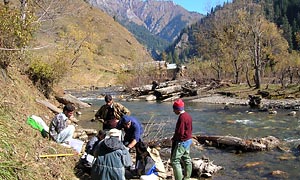Development of a Science Based Restoration and Management Plan for the San Rafael River, UT: Integrating Data on Fish Distributions and Habitat Needs with Historical Analyses of Channel Change
Date:
2012-2013
Abstract:
Like many rivers in the southwestern US, the San Rafael River in east central Utah has been impacted by hydrological alterations, habitat fragmentation, and non-native woody riparian vegetation establishment. In the lower San Rafael River in particular, spring snowmelt floods have declined in magnitude and duration due to water capture in the upper portion of the basin. However, summer monsoon floods still occur regularly and transport large quantities of sediment into the lower river. This sediment is no longer exported from the river channel due to the loss of spring snowmelt floods. As a result, the channel has narrowed and deepened, the floodplain has aggraded, and backwaters and other off-channel habitats have filled with sediment. Non-native saltcedar (Tamarix sp.) has colonized the river banks in high densities and exacerbated floodplain aggradation and channel narrowing by stabilizing bank and floodplain sediments. The combination of reduced spring snowmelt flows and saltcedar colonization has led to a narrowing and simplification of the river channel, which is now primarily dominated by low-velocity, sandy run or glide habitat. Three native species found in the San Rafael, the bluehead sucker (Catostomus discobolus), flannelmouth sucker (Catostomus latipinnis), and roundtail chub (Gila robusta), are currently protected under a Conservation Agreement. However, "the three species" occur in low abundance in the lower river, due to poor habitat quality and the presence of non-native fish species.
We are combining hydrological and geomorphological analyses of channel change with data on current fish distributions and habitat needs to help guide restoration efforts on the lower San Rafael. We are planning to apply an experimental approach to the restoration design, so that we can understand the cumulative impacts of different restoration projects over a large scale. We envision that the outcomes of the San Rafael restoration project will help inform restoration efforts throughout the southwestern US.
Funding:
- Primary: Bureau of Land Management
- Bureau of Reclamation & U.S. Geological Survey – UCFWRU (in-kind)
Investigators:
- Phaedra Budy, Principle Investigator, USGS – UCFWRU, USU- Dept. of Watershed Sciences
- Brian Laub, Postdoctoral Fellow, USU- Dept. of Watershed Sciences
- Justin Jimenez, Fisheries/Riparian Program Lead, BLM Utah State Office
- David Dean, Researcher, USU- Dept. of Watershed Sciences




